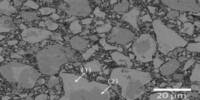Magnesium polonide (MgPo) is a salt of magnesium and polonium. It is a polonide, a set of very chemically stable compounds of polonium. Polonium is a radioactive element, and compounds containing it are generally highly radioactive and hazardous to handle due to the emission of alpha particles. Due to the radioactive nature of polonium isotopes, magnesium polonide is also unstable and may undergo radioactive decay over time.
Preparation
Magnesium polonide can be produced by heating a mixture of elemental magnesium and polonium at 300–400 °C.
Structure
Magnesium polonide has the nickeline (NiAs) structure. It is unusual among polonides in not being isomorphous with the corresponding sulfide, selenide and telluride; only mercury polonide (HgPo) shares this property. The density would depend on its specific crystal structure, which in turn can be influenced by temperature and pressure. However, it is generally expected to have a relatively high density.
Here are a few key points about magnesium polonide:
- Chemical Composition: MgPo2 is composed of magnesium ions (Mg2+) and polonium ions (Po2-). In this compound, magnesium has a +2 oxidation state, and polonium has a -2 oxidation state.
- Radioactivity: Polonium is highly radioactive and can emit alpha particles, which are composed of two protons and two neutrons. This radiation is harmful to living organisms and requires careful handling and containment.
- Rare and Synthetic: Polonium is a rare element, and magnesium polonide is not naturally occurring. It is typically synthesized in a laboratory setting for research purposes.
- Melting and Boiling Points: The melting and boiling points would also depend on various factors. Polonium has a relatively low melting point for a metal, so the compound may have a lower melting point than other magnesium compounds.
- Solubility: It is likely to have very limited solubility in water due to the insolubility of many polonide compounds.
Applications
Due to its extreme radioactivity, magnesium polonide does not have any practical applications outside of scientific research. It has been used in nuclear physics experiments to study the properties of polonium and its interactions with other elements.
Hazards
Handling magnesium polonide or any compound containing polonium requires specialized equipment and precautions to protect against radiation exposure. It is not a substance that can be safely used outside of controlled laboratory settings.
It is a synthetic compound composed of magnesium and polonium atoms, and it is highly radioactive, making it important for scientific research but too hazardous for most practical applications.
















